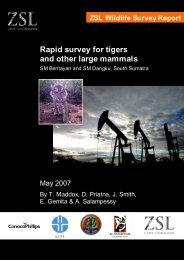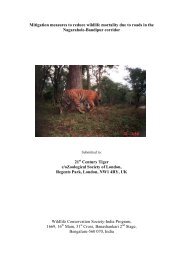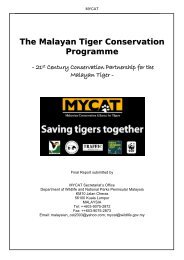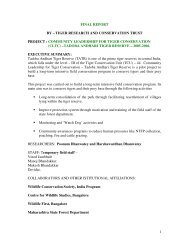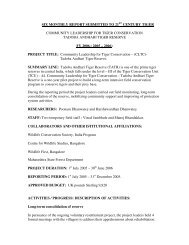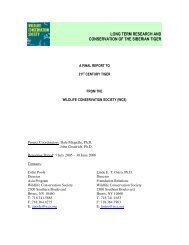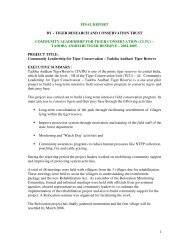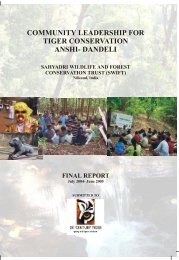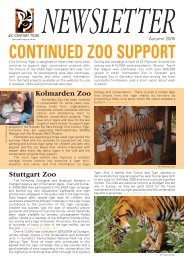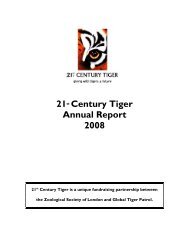The conservation of tigers and other wildlife in oil palm plantations
The conservation of tigers and other wildlife in oil palm plantations
The conservation of tigers and other wildlife in oil palm plantations
You also want an ePaper? Increase the reach of your titles
YUMPU automatically turns print PDFs into web optimized ePapers that Google loves.
Summary <strong>of</strong> recommendations for mitigation <strong>of</strong> damag<strong>in</strong>g<br />
impacts <strong>of</strong> <strong>oil</strong> <strong>palm</strong> <strong>plantations</strong> on <strong>wildlife</strong><br />
1. When a new plantation is to be established:<br />
a. Detailed <strong>wildlife</strong> surveys must be carried out beforeh<strong>and</strong> by capable <strong>and</strong><br />
<strong>in</strong>dependent bodies, preferably us<strong>in</strong>g approved st<strong>and</strong>ardised methodology,<br />
not only at all potential locations but over the whole surround<strong>in</strong>g area.<br />
b. New <strong>plantations</strong> should be established only on areas shown by these surveys<br />
to be <strong>of</strong> low <strong>conservation</strong> value (bear<strong>in</strong>g <strong>in</strong> m<strong>in</strong>d that high <strong>conservation</strong><br />
values can occur <strong>in</strong> areas not classified as forest).<br />
c. <strong>The</strong> results <strong>of</strong> the surveys for the whole area should be exam<strong>in</strong>ed by<br />
government at a regional level <strong>and</strong> priority given to reta<strong>in</strong><strong>in</strong>g habitat l<strong>in</strong>kages<br />
<strong>in</strong> the overall mosaic <strong>of</strong> l<strong>and</strong> uses as well as to ensur<strong>in</strong>g the area selected<br />
for the concession has low <strong>conservation</strong> value.<br />
2. When an exist<strong>in</strong>g plantation wishes to m<strong>in</strong>imise its impact on local <strong>wildlife</strong>:<br />
a. <strong>The</strong>ir major focus should be on the sit<strong>in</strong>g <strong>and</strong> management <strong>of</strong> unplanted<br />
areas on the concession l<strong>and</strong>.<br />
b. A m<strong>in</strong>imum <strong>of</strong> 10% <strong>of</strong> concession l<strong>and</strong> (over <strong>and</strong> above what is already<br />
legally required to be left unplanted such as river buffer zones) should be<br />
set aside for <strong>wildlife</strong> <strong>conservation</strong> purposes.<br />
c. Plac<strong>in</strong>g <strong>of</strong> these <strong>conservation</strong> areas should be decided with consideration<br />
given to the nature <strong>of</strong> the areas surround<strong>in</strong>g the plantation <strong>and</strong> the<br />
species <strong>of</strong> <strong>wildlife</strong> present <strong>in</strong> the area:<br />
i. When a plantation concession constitutes a barrier between two<br />
areas with high <strong>conservation</strong> value, a habitat corridor between<br />
the two should be put <strong>in</strong> place.<br />
ii. When a plantation borders areas with high <strong>conservation</strong> value,<br />
buffer zones along these borders should be put <strong>in</strong> place.<br />
iii. When a plantation does not connect with high <strong>conservation</strong> value<br />
areas, <strong>wildlife</strong> refuges (isl<strong>and</strong>s <strong>of</strong> habitat with<strong>in</strong> the plantation<br />
concession) should be put <strong>in</strong> place to provide habitat for smaller<br />
species <strong>and</strong> stepp<strong>in</strong>g stones for any larger species that are sufficiently<br />
tolerant <strong>of</strong> <strong>oil</strong> <strong>palm</strong> to use them.<br />
d. All such set-aside areas should be actively managed; if this is not done they<br />
will be perceived as available for settlement <strong>and</strong> lost to both the plantation<br />
<strong>and</strong> the <strong>wildlife</strong>. Management should <strong>in</strong>volve:<br />
i. Mark<strong>in</strong>g the areas with signs or plant<strong>in</strong>gs.<br />
ii. Active protection by security patrols.<br />
iii. If possible, also monitor<strong>in</strong>g <strong>of</strong> the <strong>wildlife</strong> us<strong>in</strong>g the areas - which<br />
will provide promotional material for the plantation as well as a<br />
record <strong>of</strong> the usefulness <strong>of</strong> the set-aside.<br />
e. Due consideration should also be given to m<strong>in</strong>imis<strong>in</strong>g environmental<br />
pollution eg from pesticides <strong>and</strong> process<strong>in</strong>g (details <strong>of</strong> this are outside the<br />
scope <strong>of</strong> this report).<br />
3. When a plantation wishes to fully compensate for its environmentally damag<strong>in</strong>g<br />
effects on <strong>wildlife</strong>:<br />
a. This is not possible through set-aside <strong>and</strong> management.<br />
b. Plantations should therefore <strong>of</strong>fset the rema<strong>in</strong><strong>in</strong>g impacts by support<strong>in</strong>g<br />
<strong>of</strong>f-site <strong>conservation</strong> efforts.<br />
c. This may be done by f<strong>in</strong>anc<strong>in</strong>g avoidance <strong>of</strong> deforestation elsewhere, by<br />
f<strong>in</strong>anc<strong>in</strong>g active <strong>conservation</strong> projects elsewhere, or by <strong>other</strong> relevant<br />
mechanisms.<br />
4. All action taken by the <strong>oil</strong> <strong>palm</strong> <strong>in</strong>dustry to mitigate the effects <strong>of</strong> the <strong>in</strong>dustry on<br />
<strong>wildlife</strong> should:<br />
a. Be conducted with<strong>in</strong> exist<strong>in</strong>g frameworks (RSPO, HCVF) to ensure transparency,<br />
accountablity <strong>and</strong> compatibility.<br />
b. Be conducted as part <strong>of</strong> a l<strong>and</strong>scape-scale <strong>conservation</strong> programme to<br />
ensure the small contributions each <strong>in</strong>dividual plantation is able to make<br />
comb<strong>in</strong>e to produce a significant impact on a larger scale.<br />
5. All <strong>wildlife</strong> survey data collected by <strong>plantations</strong> <strong>and</strong> collaborat<strong>in</strong>g agencies should be<br />
preserved <strong>and</strong> made widely available through the RSPO <strong>and</strong>/or <strong>other</strong> suitable bodies.<br />
Wildlife <strong>conservation</strong> <strong>in</strong> <strong>oil</strong> <strong>palm</strong> <strong>plantations</strong> 57




